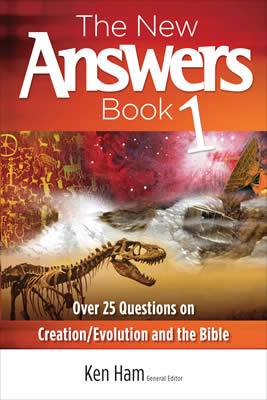
Chapter 15
Don’t Creationists Believe Some “Wacky” Things?
When answering questions about the creation/evolution issue, I have often been accused of believing some strange things. Some accuse me of believing, for example, that the earth is flat, that animals don’t change, or that the earth literally sits on several pillars. When I tell these people I don’t believe these things, they are sometimes shocked. I suspect these rumors exist to convince unsuspecting people that the Bible isn’t true. With a little research, we can easily debunk some of these myths.
1. Claim: Biblical Creationists Believe the Earth Is Flat.
This charge is often leveled at biblical creationists the moment the Bible is brought up. As far as I’m aware, no biblical creationists believe this. The Bible doesn’t teach a flat earth, and this belief was never widespread.1 In fact, the Bible plainly teaches the earth isn’t flat, so it shouldn’t be an issue:
It is He who sits above the circle of the earth, and its inhabitants are like grasshoppers, who stretches out the heavens like a curtain and spreads them out like a tent to dwell in. (Isaiah 40:22, emphasis added)
He drew a circular horizon on the face of the waters, at the boundary of light and darkness. (Job 26:10, emphasis added)

Flat-earth beliefs were rather common in ancient Greece before 500 BC. This belief resurfaced in the early AD 300s with Lactantius; few others throughout history, though, have held to it. The humanists later revived this strange belief during the Renaissance and tried to imply that Christians, for the most part, believed this view. However, this simply wasn’t the case.2 Instead, the humanists took some biblical passages out of context. One such example is Revelation 7:1, which prophetically refers to the four corners of the earth. Instead of understanding the figurative nature of the verse, the humanists attempted to impose a strictly literal meaning on the passage. This passage is obviously referring to the directions of North, South, East, and West. Expositor John Gill comments on this verse:
Four angels are mentioned, in allusion to the four spirits of the heavens, in Zec 6:5; and though the earth is not a plain square with angles, but round and globular, yet it is said to have four corners, with respect to the four points of the heavens; and though there is but one wind, which blows sometimes one way, and sometimes another, yet four are named with regard to the above points, east, west, north, and south, from whence it blows.3
Poetic passages, such as Psalm 75:3, which refers to the “pillars” of the earth, were also used to discredit Christians. Commentators such as John Gill4 and Matthew Henry5 rightly point out the figurative nature of these passages.
Recommended reading: Taking Back Astronomy (Chapter 2)
2. Claim: Biblical Creationists Don’t Believe There Are “Beneficial” Mutations.
Mutations in and of themselves are usually harmful, and we would expect this because of the Curse. Most of the other mutations are static, meaning they don’t really affect the organism as a whole. However, there are a few cases of beneficial mutations that have been observed—these are different from mutations that cause the alleged gain of new genetic information. In fact, they should be referred to as mutations with beneficial outcomes—you’ll see why in a moment.
A mutation that causes a beetle to lose its wings would be considered beneficial if the beetle lived on a windy island. It would be beneficial because it might keep the beetle from blowing out to sea to die. However, this mutation causes a loss of genetic information since the beetle no longer has the information to make wings. It could also be considered a harmful mutation since it can’t get away from predators as easily.

The mutation that causes sickle cell anemia could be considered beneficial because it protects against malaria. However, the person with this mutation has lost the information to make proper, efficient blood cells, and sickled blood cells cause many problems.
Both of these mutations were beneficial to the individual but were the result of a loss of information. This means mutations, even beneficial ones, are going in the opposite direction for molecules-to-man evolution, which requires a gain of new genetic information, even though there may have been a beneficial outcome.
Consider chickens that lost the information to produce feathers.6 This can be considered “beneficial” because we no longer have to pluck them! But the chickens can’t fly and have trouble keeping warm. Often, people confuse gains of new information with beneficial mutations, but they are different. For molecules-to-man evolutionary changes, the mutation needs to be beneficial and cause a gain of new information.
Recommended reading: War of the Worldviews, Chapter 3: Are Mutations Part of the “Engine” of Evolution?
3. Claim: You Can’t Be a Christian If You Don’t Believe in a Young Earth.
Answers in Genesis has continually claimed that one can be a Christian regardless of one’s stance on the age of the earth or evolution. However, as AiG has also pointed out, these Christians are not being consistent.
Believing in a younger age of the earth (about 6,000 years) is a corollary of trusting the Bible. First, we start with the first five days of creation, then Adam was made on the sixth day, then adding ages given in the genealogies from Adam to Abraham we get about 2,000 years. Both secular historians and Christians place Abraham at about 2,000 BC, so “the beginning” would be about 6,000 years ago. So the earth is about 6,000 years old—which is old—but much younger than the billions of years that are commonly touted.
| Time | Total Time | |
|---|---|---|
| First 5 days of creation | 5 days | 5 days |
| Adam on Day 6 to Abraham | ~2000 years | Still ~2000 years |
| Abraham to Christ | ~2000 years | ~4000 years |
| Christ until today | ~2000 years | ~6000 years |
Believing in an approximately 6,000-year-old earth sets a proper foundation for believing Jesus because you are letting God speak through His Word, without taking ideas to the Bible. In the same way, by trusting the Bible first, we realize that sin and death are intrusions into the world that go back to Genesis 3—which is the foundation for the gospel. Jesus came to save us from sin and death.
If you give up this foundation of starting with the Bible and you insert evolutionary/millions-of-years ideas for the past history of the world over the Bible’s teachings in Genesis, it is inconsistent to believe the rest of the Bible—particularly the gospel. Sadly, people do it, and it is wrong, but it won’t negate their salvation.
See other chapters in this book:
Chapter 8: Could God Really Have Created Everything in Six Days?
Chapter 9: Does Radiometric Dating Prove the Earth Is Old?
Chapter 19: Does Distant Starlight Prove the Universe Is Old?
4. Claim: Biblical Creationists Take the Whole Bible Literally.
It is better to say that creationists read and understand the Bible according to the grammatical-historical approach to Scripture. That is, we understand a biblical passage by taking into account its context, author, readership, literary style, etc. In other words, we read and understand the Bible in a plain or straightforward manner. This is usually what people mean when they say “literal interpretation of the Bible.” This method helps to eliminate improper interpretations of the Bible.
But we have renounced the hidden things of shame, not walking in craftiness nor handling the word of God deceitfully, but by manifestation of the truth commending ourselves to every man’s conscience in the sight of God. (2 Corinthians 4:2)
All the words of my mouth are with righteousness; nothing crooked or perverse is in them. They are all plain to him who understands, and right to those who find knowledge. (Proverbs 8:8–9)
Reading the Bible “plainly” means understanding which passages are written as historical narrative, which are written as poetry, which are written as parable, which are written as prophecy, and so on. The Bible is written in many different literary styles and should be read accordingly. Genesis records actual historical events; it was written as historical narrative, and there is no reason to read it as any other literary style, such as allegory or poetry.
For example, a non-Christian once claimed, “The Bible clearly says ‘there is no God’ in Psalm 14:1.” However, this verse in context says:
The fool has said in his heart, “There is no God.” They are corrupt, they have done abominable works, there is none who does good. (Psalm 14:1)
The context helps determine the proper interpretation—that a fool claims there is no God.
Someone else claimed, “To interpret the days in Genesis, you need to read 2 Peter 3:8, which indicates the days are each a thousand years.” Many people try to use this passage to support the idea that the earth is millions or billions of years old, but let’s read it in context:
But, beloved, do not forget this one thing, that with the Lord one day is as a thousand years, and a thousand years as one day. The Lord is not slack concerning His promise, as some count slackness, but is long-suffering toward us, not willing that any should perish but that all should come to repentance. (2 Peter 3:8–9)
This passage employs a literary device called a simile. Here, God compares a day to a thousand years in order to make the point that time doesn’t bind Him, in this case specifically regarding His patience. God is eternal and is not limited to the time He created.
Also, this verse does not reference the days in Genesis, so it is not warranted to apply this to the length of the days in Genesis 1. When read plainly, these verses indicate that God is patient when keeping His promises. The gentleman that spoke to me had preconceived beliefs based on man’s ideas that the earth was millions of years old. Those beliefs led him to this strange interpretation as opposed to using the historical-grammatical method.
So, biblical Christians read the Bible plainly, or straightforwardly, and in context. Accordingly, we learn from what God says and means, and we don’t apply strange literalistic (in the strict sense) meanings on metaphorical or allegorical passages, and vice versa.
Recommended reading: “Why Do You Take the Bible Literally?
5. Claim: Biblical Creationists Don’t Have Any Evidence for Their Position.
In fact, we have the same evidence that evolutionists have, whether bones, fossils, or rocks. The difference is the interpretation of the evidence. Creationists and evolutionists begin with different starting points when looking at the same evidence, which is why they arrive at different conclusions.
As biblical Christians, we trust as our axiom, or starting point, that God exists and that His Word is truth. From there, we use the Bible to explain the evidence we see in the world around us. Evolutionists commonly use their axiom (naturalism/materialism and a belief that molecules-to-man evolution is true) to interpret evidence. When carefully analyzing the two interpretations, the biblical interpretation is vastly superior—it explains the evidence and is confirmed by operational science.
Recommended reading: War of the Worldviews, Chapter 12: What’s the Best “Proof” of Creation?
See chapter 1 in this book: Is There Really a God?
6. Claim: Biblical Creationists Believe the Earth Is the Same Now as It Was at the Beginning of Creation.
Biblical creationists believe that significant changes have happened to the earth in its 6,000-year history—two very catastrophic ones: the Fall and the Flood.
The Fall was when Adam and Eve disobeyed God. Prior to this, the earth and all of creation was perfect (Genesis 1:31; Deuteronomy 32:4). Adam was given only one command in this perfect world, not to eat from the fruit of the Tree of the Knowledge of Good and Evil. If he ate, his punishment would be death (Genesis 2:17).

But Adam ate, and he died (Genesis 3:19, 5:5), and now we die because we too sin (disobey God). Death and suffering entered the creation as an intrusion.
There were also other results of Adam’s disobedience (Genesis 3). One was that the ground was cursed. Another was thorns and thistles. There were changes to the animals and humans.
The Fall was a significant event that definitely caused the earth to change (Romans 8:18–22).
The Flood was God’s judgment on the people of the world who had turned their back on Him (Genesis 6–8). God said He would destroy them with a Flood, and He did.
This Flood was a global Flood that demolished everything. Many biblical creationists believe there was initially only one continent (Genesis 1:9). This original continent broke apart and was rearranged catastrophically during the Flood and the following years and finally became what we have today.
This massive Flood buried many animals, plants, and marine life, and many became fossils. A vast portion of the sedimentary rock layers we find throughout the world today is a testimony to this global Flood.
The Flood also caused ocean basins to sink down, mountains to be pushed up, etc. Major geological features resulted. Additional after-effects of the Flood were the Ice Age, plate fault lines, etc.
Biblical creationists believe the world has changed. The real question is, in what way? This is an exciting part of creationist research today.
See other chapters in this book:
Chapter 10: Was There Really a Noah’s Ark & Flood?
Chapter 14: Can Catastrophic Plate Tectonics Explain Flood Geology?
Chapter 26: Why Does God’s Creation Include Death and Suffering?
7. Claim: Biblical Creationists Are Anti-Science and Anti-Logic.
Most fields of science were developed by men who believed the Bible.
Biblical creationists love science! In fact, most fields of science were developed by men who believed the Bible, such as Isaac Newton (dynamics, gravitation, calculus), Michael Faraday (electromagnetics, field theory), Robert Boyle (chemistry), Johannes Kepler (astronomy), and Louis Pasteur (bacteriology, immunization). Francis Bacon, a Bible-believing Christian, developed the scientific method.
The reason such fields of science developed was the belief that God created the universe and that He instituted laws that we could investigate. Even today, many great scientists believe the Bible and use good observational science on a daily basis.7
Even logic flows naturally from a biblical worldview. Since we are created in the image of a logical God, we would expect to have logical faculties. However, logic is not a material entity, so it becomes a problem for the materialist atheist who denies the immaterial realm. From a materialistic perspective, a logical thought is the same as an illogical thought—merely a chemical reaction in the brain. From a materialistic point of view, then, the perception of logic is due to random processes and has nothing to do with absolute truth, which is also immaterial.
So in a biblical worldview, logic exists and so does truth, both of which are immaterial. But in a purely materialistic worldview, there is no basis for logic or truth to exist, since they are immaterial. And if our brains are the result of random mutations and natural selection, how do we know that our brains have evolved in a way that allows us to think and reason according to truth?
To state that logic can yield a truthful result means that absolute truth must exist, hence God. This does not mean that atheists and evolutionists cannot use logic or do science. But when they do, they must borrow from the above Christian principles, an action which is not consistent with their professed worldview.
Recommended reading: War of the Worldviews, Chapter 10: Can Creationists Be “Real” Scientists?
See chapter 4 in this book: Don’t Creationists Deny the Laws of Nature?
The New Answers Book 1
The New Answers Book 1 is packed with biblical answers to over 25 of the most important questions on creation/evolution and the Bible.
Read Online Buy BookFootnotes
- Who invented a flat earth? Creation 16(2):48-49, March 1994. Found online at https://answersingenesis.org/astronomy/earth/who-invented-the-flat-earth/.
- J. Gill, Exposition of the Old Testament, Notes on Revelation 7:1, 1748–1763.
- J. Gill, Exposition of the Old Testament, Notes on Psalm 75:3, 1748–1763.
- M. Henry, Matthew Henry Bible Complete Commentary, notes on Psalms 75:3.
- E. Young, Featherless chicken creates a flap, May 21, 2002, www.newscientist.com/article.ns?id=dn2307.
- R. Grigg, Meeting the ancestors, Creation 25(2):13–15, March 2003.
- To read about creation scientists and other biographies of interest, see “Creation Scientists.”
Recommended Resources

Answers in Genesis is an apologetics ministry, dedicated to helping Christians defend their faith and proclaim the good news of Jesus Christ.
- Customer Service 800.778.3390
- © 2024 Answers in Genesis




